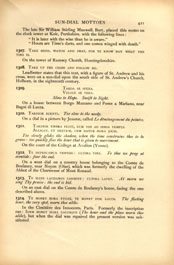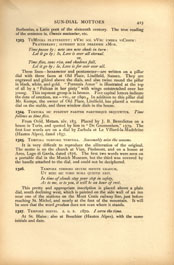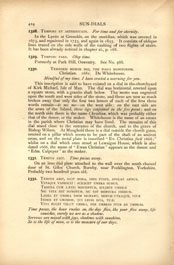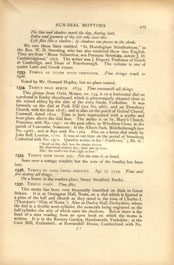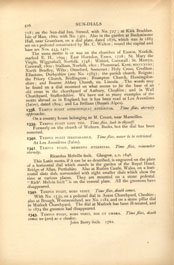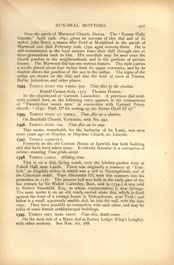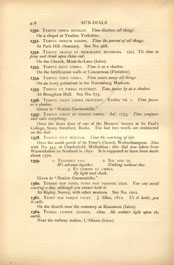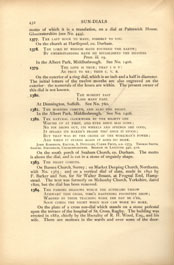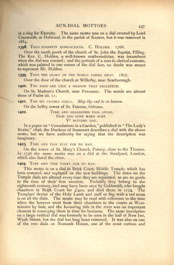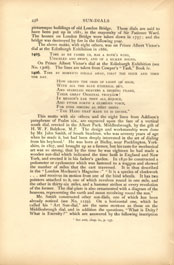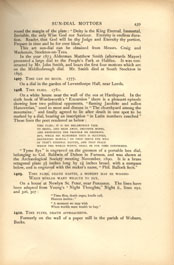Sun-Dial Mottoes (continued.)
The late Sir William Stirling Maxwell, Bart., placed this motto on the clock tower at Keir, Perthshire, with the following lines: "It is later with the wise than he is aware." |
|
| 1307. | TAKE HEED, WATCH AND PRAY, FOR YE KNOW NOT WHAT THE TIME IS. On the tower of Ramsey Church, Huntingdonshire. |
| 1308. | TAKE UP THE CROSS AND FOLLOW ME. Leadbetter states that this text, with a figure of St. Andrew and his cross, were on a sun-dial upon the south side of St. Andrew's Church, Holborn, in the eighteenth century. |
| 1309. | TARDA SE SPERA. On a house between Borgo Mazzano and Ponta a Mariano, near Bagni di Lucca. |
| 1310. | TARDIOR EGENTI. Too slow the needy. On a dial in a picture by Jeurat, called Le déménagement du peintre. |
| 1311. | TARDIOR UMBRA FLUIT, CUM VOS AD SERIA TEMPUS
Too slowly glides the shadow, when the time constrains thee to be grave: too quickly flies the hour that is given to merriment. On the court of the College of Avalion (Yonne). |
| 1312. | TE DEPRECAMUR VESPERE: ULTIME TIME. To thee we pray at eventide: fear the end. On a west dial on a country house belonging to the Comte de Boulancy, near Noyon (Oise), which was formerly the dwelling of the Abbot of the Chartreuse of Mont Renaud. |
| 1313. | TE MANE LAUDAMUS CARMINE: ULTIMA LATET. At morn we sing Thy praise: the end is hid. On an east dial on the Comte de Boulancy's house, facing the one described above. |
| 1314. | TE MONET HORA FUGAX, TE MONET IPSE LOCUS. The fleeting hour, the very spot, warn thee alike. In the Cimitière des Innocents, Paris. Formerly the inscription ran: IDEM MONET HORA LOCUSQUE (The hour and the place warn thee alike), but when the dial was repaired the present version was substituted. |
| 1315. | TE NON VIDENS SERVIRE NEQVEO. On a small honestone dial sold in London. |
| 1316. | TEGO QUOD DETEGO. I hide what I reveal. In the Basses Alpes, place unknown. |
| 1317. | TEMPORA COMPUTANTUR. The time is reckoned. On the church at Roybon. (Isère). |
| 1318. | TEMPORA CUNCTA SUIS VISITANTES DISCITE VOTIS. You who come to see me, learn all the hours by their prayers. On the church of St. Pierre, Saintes, which dates from the fifteenth century. The letters are in Gothic characters. |
| 1319. | TEMPORA LABUNTUR MORE FLUENTIS AQUAE. Like flowing water glides the time. At Monastero, near Bormida, North Italy. |
| 1320. | TEMPORA LABUNTUR QUAE NOBIS PEREUNT ET IMPUTANTUR. Time glides by which for us perishes and is reckoned. On one of the chimneys of Minster Court, Isle of Thanet. The building dates from the twelfth century. The dial was restored and the motto added by J. Swiniford, Esq., in 1856. ("Strand Magazine," 1892.) |
| 1321. |
TEMPORA LABUNTUR, TACITISQUE SENESCIMUS ANNIS,
On an ivory portarium in the British Museum. The lines are from Ovid, "Fasti," 6, 771. Also on a compass dial in the Victoria and Albert Museum. See No. 407. The first line is also on a dial at the old hospital Weekley, Northants. There is a doorway beneath the dial, on which are the words, What thou doest doe yt yn Faith, and the date 1611. |
| 1322. | TEMPORA MUTANTUR, NOS ET MUTAMUR IN ILLIS. The times change, and we to change with them. On a pillar dial in the garden of Brockhampton Park, near Cheltenham. This well-known line is not classical, but is by Matthew |
| Borbonius, a Latin poet of the sixteenth century. The true reading of the sentence is Omnia mutantur, etc. | |
| 1323. |
Or, Time flies, suns rise, and shadows fall, These lines – hexameter and pentameter – are written on a pillar dial with three faces at Old Place, Lindfield, Sussex. They are engraved and gilded above the dials, and also twine round the pillar in black, white and gold. "Perennis Amor" is illustrated at the top of all by a "Pelican in her piety" with wings outstretched over her young. This topmost group is in bronze. Five capital letters indicate the date of erection, MM – VVC., or 1890. In addition to this pillar dial Mr. Kempe, the owner of Old Place, Lindfield, has placed a vertical dial on the stable, and three window dials in the house. |
| 1324. | TEMPORA SIC FUGIUNT PARITER PARITERQUE SEQUUNTUR. Time follows as time flies. From Ovid, Metam., xiv., 183. Placed by J. B. Benedictus on a house in Turin, and quoted by him in "De Gnomonium," 1579. The first four words are on a dial by Zarbula at Le Villard-la-Madeleine (Hautes Alpes), dated 1857. |
| 1325. | TEMPORA TEMPORE TEMPERA. Seasonably seize the seasons. It is very difficult to reproduce the alliteration of the original. The motto is on the church at Vian, Piedmont, and on a house at Arco, Lago di Garda, dated 1876. The first two words were seen on a portable dial in the Munich Museum, but the third was covered by the handle attached to the dial, and could not be deciphered. |
| 1326. | TEMPORE NIMBOSO SECURI SISTITE GRADUM, This pretty and appropriate inscription is placed above a plain dial, south declining west, which is painted on the side wall of an inn near one of the stations on the Mont Cenis railway line, just before reaching St. Michel, and nearly at the foot of the mountain. It will be seen that the word gradum does not scan where it stands. |
| 1327. | TEMPORE SERVIO. Z. G. F. 1870. I serve the time. At St. Blaise; also at Bouchier (Hautes Alpes), with the same initials and date. |
| 1328. | TEMPORI ET AETERNITATE. For time and for eternity. In the Lycée at Grenoble, on the meridian, which was erected in 1673, and repainted in 1755, and again in 1855. In consists of oblique lines traces on the side walls of the vaulting of two flights of stairs. It has been already noticed in chapter xi., p. 168. |
| 1329. | TEMPORI PARE. Obey time. Formerly at Park Hill, Oswestry. See No. 988. |
| 1330. | TEMPORIS MEMOR MEI, TIBI POSUI MONITOREM. This inscription is said to have existed on a dial in the churchyard of Kirk Michael, Isle of Man. The dial was horizontal, erected upon a square stone, with a granite shaft below. The motto was engraved upon the south and west sides of the stone, and these are now so much broken away that only the first two letters of each of the first three words remain – te me me – on the west side; on the east side are the arms of the Island, three legs conjoined in the fess point; and on the north side there is the name Christian, which was probably either that of the donor, or the maker. Whitehouse is the name of an estate in the parish where Christian may have lived. The remains of this dial stand close to the entrance of the church, and to the grave of Bishop Wilson. At Maughold there is a dial outside the church gates, erected on a pillar which seems to be part of the shaft of an ancient cross, and on the metal plate is inscribed "Ev. Christian fecit 1666;" whilst on a dial which once stood at Lewaigue House, which is also dated 1666, the name of "Ewan Christian" appears as the donor, and "Edm. Culpeper" as the maker. |
| 1331. | TEMPUS ABIT. Time passes away. On an iron dial plate attached to the wall over the south chancel door of St. Giles' Church, Burnby, near Pocklington, Yorkshire. Probably two hundred years old. |
| 1332. | TEMPUS ABIT, RUIT HORA, DIES FUGIT, AVOLAT ANNUS, |
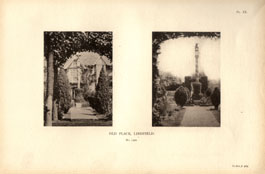
[Full Image]
OLD PLACE, LINDFIELD.
No. 1322.
To face page 424.
The line and shadow mark the day, fleeting both, We owe these lines entitled "In Horologium Sciothericum," to the Rev. W. D. Sweeting, who has also rendered them into English. They are from "Musæ Subsecivæ, seu Poemata Stromata, autore J. D. Cantabridgiensi," 1676. The writer was J. Duport, Professor of Greek at Cambridge, and Dean of Peterborough. The volume is one of quaint Latin and Greek verses. |
|
| 1333. | TEMPUS AD LUCEM DUCIT VERITATEM. Time brings truth to light. Noted by Mr. Howard Hopley, but no place named. |
| 1334. | TEMPUS EDAX RERUM. 1834. Time consumeth all things. This phrase from Ovid, Metam., xv. 234, is on a horizontal dial on a pedestal in Easby churchyard, which is picturesquely situated close to the ruined abbey by the side of the river Swale, Yorkshire. It was formerly on the dial at Park Hill (see No. 988); and on Dewsbury Church, with the date 1816; and is also on the porch of Gulval Church, Cornwall, dated 1810. Time is here represented with a scythe and hour-glass, above the dial face. The motto is on St. Mary's Church, Penzance, with No. 1247; on the post office, at Wheddon Cross, in the parish of Cutcombe, Somerset: in the Albert Park, Middlesbrough (see No. 1406); and at Rye with No. 1364. Also on a brass dial made by John Bell, London, 1710. It was at one time on the portal of Strasburg Cathedral with No. 1571. Quarles writes in his "Emblems," 3, Bk. iii.: "Read on this dial, how the shades devour |
| 1335. | TEMPUS ENIM PROPE EST. For the time is at hand. Seen over a cottage window, but the note of the locality has been lost. |
| 1336. | TEMPUS ET IGNIS OMNIA PERDUNT. Ap: 17. 1719. Time and fire destroy all things. On a house in the market-place, Stony Stratford, Bucks. |
| 1337. | TEMPUS FUGIT. Time flies. This motto has been very frequently inscribed on dials in Great Britain. It is at Ossington Hall, Notts, on a dial which is figured in a plate of the hall and church as they stood in the time of Charles I. (Thoroton's "Hist. of Notts.") Also at Darley Hall, Derbyshire, where the dial is a double semi-cylinder, the numerals being engraved on the half cylinder, the side of which casts the shadows. Below there is the head of a man reading from an open book on which the motto is written. It is in the Rectory Garden, Handsworth, Yorkshire; at the Corn Mill, Ecclesfield; at Borranshill House, Cumberland, with No. |
|
718; on the Sun-Dial Inn, Stroud, with No. 727; at Kirk Braddan, Isle of Man, 1860, with No. 1301. Also in the garden at Buckminster Hall, near Grantham, on a dial plate dated 1876, which was in 1885 set on a pedestal constructed by Mr. C. Walton; round the capital and base are Nos. 443, 1421. The same motto is or was on the churches of Easton, Norfolk, marked E. H., 1694; East Horndon, Essex, 1728; St. Mary the Virgin, Wiggenhall, Norfolk, 1748; Withiel, Cornwall; St. Merryn, Cornwall, 1800; Stalham, Norfolk, 1801; Plumstead, Kent, MDCCCXVIII; North Bradley, Wilts; Otterford, Somerset; Holy Cross, Crediton; Ellastone, Derbyshire (see No. 1585); the parish church, Reigate; the Priory Church, Bridlington; Brampton Church, Huntingdonshire; and Bourne Abbey Church, co. Lincoln. The words may be found on a dial mounted on what seems to be the base of an old cross in the churchyard of Astbury, Cheshire; and in Wall Churchyard, Staffordshire. We have not as many examples of the motto abroad as in England, but it has been read at Les Avenières (Isère), dated 1804; and La Brillane (Basses Alpes). |
|
| 1338. | TEMPUS FUGIT ADPROPINQUAT ÆTERNITAS. Time flies, eternity approaches. On a country house belonging to M. Crozet, near Marseilles. |
| 1339. | TEMPUS FUGIT CAVE TIBI. Time flies, look to thyself. Formerly on the church of Woburn, Bucks, but the dial has been removed. |
| 1340. | TEMPUS FUGIT IRREPARABILE. Time flies, never to be retrieved. At Les Avenières (Isère). |
| 1341. | TEMPUS FUGIT, MEMENTO ÆTERNITAS. Time flies, remember eternity.
This Latin motto, if it can be so described, is engraved on the plate of a horizontal dial which stands in the garden of the Royal Hotel, Bridge of Allan, Perthshire. Also at Ruthin Castle, Wales, on a horizontal slate slab, surrounded with eight smaller dials which show the time at various places. They are mounted on a stone pedestal. "Richd. Melvin fecit" is on the central plate. All the gnomons have disappeared. |
| 1342. | TEMPUS FUGIT, MORS VENIT. Time flies, death comes. With No. 1530, on a pedestal dial in Acton Churchyard, Cheshire; also at Brough, Westmoreland, see No. 1182, and on a stone pillar dial in Matlock Churchyard. The dial at Matlock has been ill-treated, and in 1874 the gnomon had disappeared. |
| 1343. | TEMPUS FUGIT, MORS VENIT, NOS UT UMBRA. Time flies, death comes we (are) as a shadow.
John Berry fecit. 1762. |
Over the porch of Marwood Church, Devon. The "Exeter Daily Gazette," April 29th, 1891, gives an account of this dial and of its maker, John Berry, a mason who lived at Muddiford in the parish of Marwood, and died February 20th, 1790, aged seventy-three. He is still remembered, as the local masons trace their skill through two or three generations back to him. His sun-dials may be seen over the church porches in the neighbourhood, and in the gardens of private houses. The Marwood dial has one curious feature. The style carries a needle placed about four inches from its upper extremity, and by its shadow shows the position of the sun in the zodiac. The signs of the zodiac are shown on the dial, and also the hour of noon at Vienna, Berlin, Jerusalem, and other places. |
|
| 1344. | TEMPUS FUGIT PER UMBRA (M). Time flies by the shadow.
In the churchyard of Cartmel, Lancashire. A previous dial evidently existed here, as the following entry appears in the transactions of "Twenty-four sworn men," in connection with Cartmel Priory church: "1630: Paid, Itm for setting up the Sunne Dyell iijs vjd." |
| 1345. | TEMPUS FUGIT UT UMBRA. Times flies as a shadow. On Bradfield Church, Yorkshire, with No. 992. |
| 1346. | TEMPUS FUGIT VIA. Time flies on its way. This motto, remarkable for the barbarity of its Latin, was seen some years ago on Haydor, or Heydour Church, co. Lincoln. |
| 1347. | TEMPUS LABANTUR. Formerly on the old Custom House at Ipswich, but both building and dial have been taken away. Evidently labantur is a corruption of labitur, meaning Time glides away. |
| 1348. | TEMPUS LABILE. Gliding time. This is on a dial, facing south, over the kitchen-garden door at Esholt Hall, near Leeds. There was originally a nunnery at "Esteholt," as Dugdale writes it, which was a cell to Sinningthwait, and of the Cistercian order. Pope Alexander III. took this nunnery into his protection in 1172. The present hall was built in the early part of the last century by Sir Walter Calverley, Bart., and in 1754-5 it was sold to Robert Stansfield, Esq., to whose representative it now belongs. The same motto is on an old, nicely-carved stone dial, which is fixed against the front of a cottage house in Bishopthorpe, near York; and below is a small, apparently marble slab, let into the wall, with the date 1691. They have possibly no connection with each other, and may be relics of some former archiepiscopal buildings. |
| 1349. | TEMPUS OBIT, MORS VENIT. Time dies, death comes. On the west side of a Manx dial at Barnes Lodge, King's Langley, with other mottoes. See Nos. 161, 788. |
| 1350. | TEMPUS OMNIA REVELAT. Time discloses all things. On a chapel at Yeadon, Yorkshire. |
||||
| 1351. | TEMPUS OMNIUM PARENS. Time the parent of all things. At Park Hill, Oswestry. See No. 988. |
||||
| 1352. | TEMPUS ORANDI ET MEMORANDI NOVISSIMA. (sic) 'Tis time to pray and think upon thine end. On the Church, Mont-de-Lans (Isère). |
||||
| 1353. | TEMPUS SICUT UMBRA. Time is as a shadow. On the fortification walls at Concarneau (Finistère). |
||||
| 1354. | TEMPUS TERIT OMNIA. Time wears away all things. On an ivory portarium in the Nuremberg Museum. |
||||
| 1355. | TEMPUS UT UMBRA PRÆTERIT. Time passes by as a shadow. At Brougham Hall. See No. 875. |
||||
| 1356. | TEMPUS VELUT UMBRA PRÆTERIT. Eccles. vii. I. Time passes as a shadow. Given in "Notizie Gnomoniche." |
||||
| 1357. | TEMPUS VINCIT ET DIRIGIT OMNIA. Ano. 1773. Time conquers and rules everything. Over the front door of one of the Masters' houses at St. Paul's College, Stony Stratford, Bucks. The last two words are contracted on the dial. |
||||
| 1358. | TEMPUS VITÆ MONITOR. Time the warning of life. Over the south porch of St. Peter's Church, Wolverhampton. Also with No. 443, at Charlesfield, Midlothian; this dial was taken from Warwickshire to Scotland in 1892. It is supposed to have been made about 1770. |
||||
| 1359. |
Given in "Notizie Gnomoniche." |
||||
| 1360. | TENERE NON POTES, POTES NON PERDERE DIEM. You can avoid wasting a day, although you cannot hold it. At Ripley, Surrey, with other mottoes. See No. 1002. |
||||
| 1361. | TENET NOS VOSQUE VOCAT. J. Silau, 1812. Us it holds, you it calls. On the church near the cemetery at Réaumont (Isère). |
||||
| 1362. | TERRAS LUMINE SPARGIT. 1800. He scatters light upon the earth. Near the railway station, L'Albenc (Isère). |
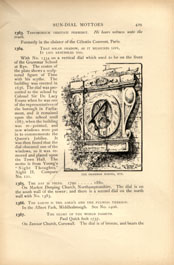
[Full Image]
THE GRAMMAR SCHOOL, RYE.
| 1363. | TESTIMONIUM VERITATI PERHIBET. He bears witness unto the truth. Formerly in the cloister of the Célestin Convent, Paris. |
| 1364. | THAT SOLAR SHADOW, AS IT MEASURES LIFE, With No. 1334 on a vertical dial which used to be on the front of the Grammar School at Rye. The centre of the plate shows a sculptured figure of Time with his scythe. The building was erected in 1636. The dial was presented to the school by Colonel Sir De Lacy Evans when he was one of the representatives of the borough in Parliament, and it remained upon the school until 1887, when the building was re-pointed, and new windows were put in to commemorate the Queen's Jubilee. It was then found that the dial obscured one of the windows, so it was removed and placed upon the Town Hall. The motto is from Young's "Night Thoughts," Night II. Compare No. 121. |
| 1365. | THE DAY IS THINE. 1790 . . . . . 1880. On Market Deeping Church, Northamptonshire. The dial is on the south wall of the tower; and there is a second dial on the north wall with No. 1383. |
| 1366. | THE EARTH IS THE LORD'S AND THE FULNESS THEREOF. In the Albert Park, Middlesbrough. See No. 1406. |
| 1367. | THE GLORY OF THE WORLD PASSETH.
On Zennor Church, Cornwall. The dial is of bronze, and bears the |
| figure of a mermaid, the "mermaid of Zennor," with whom, according to the legend, the squire's son fell in love. The mermaid allured him to the sea, and he was seen no more. The mermaid is also introduced into the carving of one of the old oak bench ends in the church. | |||
| 1368. | THE GREATER LIGHT TO RULE THE DAY (Gen. i. 16). On a remarkable dial formerly on the church of St. Mary le Tower, Ipswich. It was of large size, and filled the whole space of a window within an arch which had apparently been plastered up to admit of the dial being placed there. On the dial face were painted the twelve signs of the zodiac in colours. Below, at the left-hand corner, there was a figure of Atlas bearing the terrestrial globe on his shoulders, and on the right, Science regarding the celestial globe; above, at the left-hand corner, Time, with his scythe and hour-glass, and at the right, Death. This dial was removed about 1860, and cannot now be traced. It probably dated from the eighteenth century. The same text is on Copdock Church, Suffolk. On the tower of Thorp Arch Church, Yorkshire, there is a square stone dial inscribed, "I Gen. 16," which is no doubt intended to refer the spectator to the same text. |
||
| 1369. | THE HOUR COMETH. A.D. 1826. On the porch of Saxthorpe Church, Norfolk. The dial was put up in 1826 by Lieutenant Davis, R.N. |
||
| 1370. | THE HOUR IS AT HAND. At Harlston, Northants. |
||
| 1371. | THE HOUR IS COMING IN THE WHICH ALL THAT ARE IN THE GRAVES SHALL HEAR HIS VOICE. M DCCC XXX III. St. John, v. 28. In the churchyard at Stretton, Cheshire. |
||
| 1372. | THE HOUR IS SHOWN ON OTHER DIALS BUT WHEN THE SUN DOTH SHINE, On a mock dial at an old inn in Somersetshire. There are four hands figured, each having three hours opposite to it, so that one of the hands is always pointing to the right hour ("Birmingham Weekly Mercury"). |
||
| 1373. |
On a horizontal dial in Sulham Churchyard, Berks. |
||
| 1374. | THE HOURS ARE GRAVEN ROUND THE CROSS'S SIDES, |
IF THE SUN SHINES, AND DRAWS A LINE, REDEEM These lines were written by the Rev. R.W. Essington, and engraved on a cross dial which he has erected at his present home, Plen, Newquay, Cornwall. The dial stands on a pedestal formed from an old stone roller. The stanza is similar to that which Mr. Essington inscribed on his cross dial at Shenstone (see No. 474), but he altered it in order to explain how the hour lines are thrown by the shadows of the cross. |
|
| 1375. | THE HOURS PART US, This motto was devised by the late Julia Horatia Ewing, with the intention of placing it on a sun-dial which she and her husband offered to erect, as a parting gift, upon the Mess Hut of the Royal Engineers, South Camp, Aldershot, 1877, "In grateful record of happy hours spent there." The dial was not erected, however, as another offering was preferred in its place, but the motto is inserted here as an illustration of one of the lessons which the devisor learnt from the shifting scenes of life amongst which she lived for seven years in Aldershot Camp. The same thought was more fully set forth in her "Story of a Short Life" (p. 75). "True to its character as an emblem of human life, the Camp stands on, with all its little manners and customs, whilst the men who garrison it pass rapidly away. Strange as the vicissitudes of a whole generation elsewhere, are the changes and chances that a few years bring to those who were stationed there together. To what unforseen celebrity (or to a dropping out of one's life and even hearsay, that once seemed quite as little likely) do one's old neighbours sometimes come! They seem to pass in a few dull seasons as other men pass by lifetimes. Some to foolishness and forgetfulness, and some to fame. This old acquaintance to unexpected glory; that dear friend – alas! – to the grave. And some – GOD speed them! – to the world's end and back, following the drum till it leads them home again, with familiar faces little changed – with boys and girls, perchance, very greatly changed – and with hearts not changed at all. Can the last parting do much to hurt such friendships between good souls who have so long learnt to say farewell; to love in absence, to trust through silence, and to have faith in reunion?" |
| 1376. | THE HOURS, UNLESS THE HOURS BE BRIGHT, Written by the late W. H. Hyett, Esq., and placed with the Latin |
| motto of which it is a translation, on a dial at Painswick House, Gloucestershire (see No. 444). | |
| 1377. | THE LAST HOUR TO MANY, POSSIBLY TO YOU. On the church at Hartlepool, co. Durham. |
| 1378. | THE LORD BY WISDOM HATH FOUNDED THE EARTH; Prov. iii. 19. In the Albert Park, Middlesbrough. See No. 1406. |
| 1379. | THE LOVE IS TRUE, THAT I O V: On the exterior of a ring dial, which is an inch and a half in diameter. The initial letters of the twelve months are also engraved on the exterior: the numerals of the hours are within. The present owner of this dial is not known. |
| 1380. | THE MOMENT PAST At Dennington, Suffolk. See No. 760. |
| 1381. | THE MORNING COMETH, AND ALSO THE NIGHT. In the Albert Park, Middlesborough. See No. 1406. |
| 1382. | THE NATURAL CLOCKWORK BY THE MIGHTY ONE JOHN ROBINSON, RECTOR, A. DOUGLASS, CLERK FECIT, A.D. 1773. JHOMAS SMITH, SAMUEL STEVENSON, CHURCHWARDENS. SEAHAM IN LATITUDE 54D. 51M. On the south porch of Seaham Church, co. Durham. The motto is above the dial, and is cut in a stone of ungainly shape. |
| 1383. | THE NIGHT COMETH. On Barnes Church, Surrey; on Market Deeping Church, Northants, with No. 1365; and on a vertical dial of slate, made in 1892 by F. Barker and Son, for Sir Walter Besant, at Frognal End, Hampstead. The text was formerly on Melsonby Church, Yorkshire, dated 1800, but the dial has been removed. |
| 1384. | THE PASSING SHADOWS WHICH THE SUNBEAMS THROW On the plate of a cross sun-dial which stands on a stone pedestal upon the terrace of the hospital of St. Cross, Rugby. The building was erected in 1882, chiefly by the liberality of R. H. Wood, Esq., and his wife. There are mottoes in the wards and over some of the door- |
ways; that over the porch is "Deus nobis haec otia fecit – anno salutis 1882." Over the out-patients' entrance is one which is often used as a dial motto, "Post tenebras spero lucem." The lines on the cross dial were written by R. E. Egerton-Warburton, Esq. See No. 715. The dial was designed by the late Henry Wilson, Esq. of Gray's Inn Square, London, who was the architect of the hospital, and he selected the fine old characters in which the lines of the motto are engraved. |
|
| 1385. | THE SMALL AND THE GREAT ARE THERE; AND SERVANT IS FREE FROM HIS MASTER. Job, iii. 19. One of four mottoes on the dial at the gateway of St. Patrick's Church, Patrick, Isle of Man. See No. 864. |
| 1386. | THE SUN RIDES POST, TIME FLYS AWAY, On a ring dial. See "Proceedings of the Society of Antiquaries," February, 1894. |
| 1387. | THE SUN SHALL NOT SMITE THEE BY DAY, NOR THE MOON BY NIGHT. Psalm cxxi. 6. On one side of a stone cube, which bears a dial on the opposite side. This formerly stood on a pedestal, crowned with a stone ball, at Birnie, Morayshire. The cube is now in the possession of Mr. Muil, at Strypes, near Elgin. |
| 1388. | THE SUNLIT DIAL SHOWS Composed by R. E. Egerton-Warburton, Esq., for a dial on a church at Warburton, Cheshire. |
| 1389. | THE TIME IS AT HAND. Noticed in the "Gentleman's Magazine," November, 1765; no locality is given. |
| 1390. | THE TIME IS SHORT. I Cor. vii. 24. Placed in 1882 on the church of Kilnwick, Yorkshire. See No. 355. |
| 1391. |
On an engraving of a dial in Franz Ritter's "Speculum Solis" (Nuremberg, 1652). |
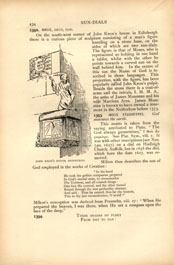
[Full Image]
JOHN KNOX'S HOUSE, EDINBURGH.
| 1392. | ΘEOΣ, DEUS, GOD. On the south-west corner of John Knox's house in Edinburgh there is a curious piece of sculpture consisting of a man's figure kneeling on a stone base, on the sides of which are two sun-dials. The figure is that of Moses, who is represented as holding in one hand a tablet, whilst with the other he points towards a carved sun on the wall behind him. In the centre of this sun the Name of God is inscribed in three languages. This projection, with the figure, has been popularly called John Knox's pulpit. Beside the stone there is a coat-of-arms and the initials I. M. M. A., the arms of James Mossman and his wife Marriota Ares. James Mossman is known to have owned a tenement in the Netherbow before 1573. |
| 1393. | ΘEOΣ ΓΕΩMETPEI. God measures the earth. This motto is taken from the saying attributed to Plato, "The God always geometrises," ὄ Θεòς ἄει γεωμέτρει. See Plat. Sym., viii. 2. It was with other inscriptions (see Nos. 740, 1657) on a dial on Hadleigh Church, Suffolk, but in 1858 the dial, which bore the date 1627, was removed. Milton thus describes the son of God employed in the works of Creation: "In his hand Milton's conception was derived from Proverbs, viii. 27: "When He prepared the heaven, I was there, when He set a compass upon the face of the deep." |
| 1394. | THESE SHADES DO FLEET |
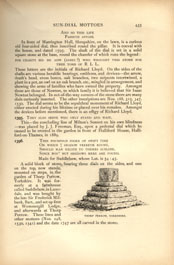
[Full Image]
THORP PERROW, YORKSHIRE.
AND SO THIS LIFE In front of Marrington Hall, Shropshire, on the lawn, is a curious old four-sided dial, thus inscribed round the pillar. It is coeval with the house, and dated 1595. The shaft of the dial is set in a solid square stone at the base, round the chamfer of which runs the legend: FOR CHARITI BID ME ADW (ADIEU?) WHO WROUGHT THIS STONE FOR THEE TOMB OF R. L. L. These letters are the initials of Richard Lloyd. On the sides of the shafts are various heraldic bearings, emblems, and devices – the arrow, death's head, cross bones, oak branches, two serpents intertwined, a plant in a pot, an owl on an oak branch, etc., mingled in arrangement, and showing the arms of families who have owned the property. Amongst these are those of Newton, to which family it is believed that Sir Isaac Newton belonged. In out-of-the-way corners of the stone there are many dials curiously inserted. The other inscriptions are Nos. 188, 315, 347, 1530. The dial seems to be the sepulchral monument of Richard Lloyd, either erected during his lifetime or placed over his remains. Amongst the devices before mentioned, there is an effigy of Richard Lloyd. |
|
| 1395. | THEY ALSO SERVE WHO ONLY STAND AND WAIT. This – the concluding line of Milton's Sonnet on his own blindness – was placed by J. J. Freeman, Esq., upon a pedestal dial which he caused to be erected in the garden in front of Halliford House, Halliford-on-Thames, in 1889. |
| 1396. | THIS FOURFOLD INDEX OF SWIFT TIME Made for Saddlebow, whose Lat. is 54:45. A solid block of stone, bearing three dials on the sides, and one on the top, now stands, mounted on steps, in the garden of Thorp Perrow, Yorkshire. It was formerly at a farmhouse called Saddlebow, in Lunedale, and was bought by the late Sir Frederick Milbank, Bart., and set up first at Wemmergill Lodge, and afterwards at Thorp Perrow. These lines and other mottoes ( Nos. 248, 1530, 1541) and the date 1747 are all carved in the stone. |
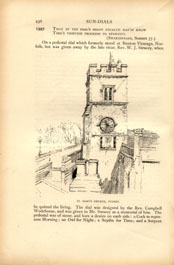
[Full Image]
ST. MARY'S CHURCH, PUTNEY.
| 1397. | THOU BY THY DIAL'S SHADY STEALTH MAY'ST KNOW On a pedestal dial which formerly stood at Buxton Vicarage, Norfolk, but was given away by the late vicar, Rev. W. J. Stracey, when he quitted the living. The dial was designed by the Rev. Campbell Wodehouse, and was given to Mr. Stracey as a memorial of him. The pedestal was of stone, and bore a device on each side: a Cock to represent Morning; an Owl for Night; a Scythe for Time; and a Serpent |
| in a ring for Eternity. The same motto was on a dial erected by Lord Cranworth, at Holwood, in the parish of Keston, but it was removed in 1884. | |
| 1398. | THUS ETERNITY APPROACHETH. C. HOLDEN. 1766. Over the south porch of the church of St. John the Baptist, Pilling. The Rev. C. Holden, a well-known mathematician, was incumbent when the dial was erected; and the portrait of a man in clerical costume, which was painted in one corner of the dial face, no doubt was meant to represent Mr. Holden. |
| 1399. | THUS THE GLORY OF THE WORLD PASSES AWAY. 1807. Over the door of the church at Willerby, near Scarborough. |
| 1400. | THY DAYS ARE LIKE A SHADOW THAT DECLINETH. On St. Madron's Church, near Penzance. The words are almost those of Psalm cii. II. |
| 1401. | TIBI SIT ULTIMA COELO. May thy end be in heaven. On the belfry tower of St. Paterne, Orleans. |
| 1402. | TIME AND SHADDOWES PASS AWAIE. In a paper on "Consolations in a Garden," published in "The Lady's Realm," 1896, the Duchess of Somerset describes a dial with the above motto, but we have authority for saying that the description was imaginary. |
| 1403. | TIME AND TIDE STAY FOR NO MAN. On the tower of St. Mary's Church, Putney, close to the Thames. In 1756 the same motto was on a dial at the Steelyard, London, which also faced the river. |
| 1404. | TIME AND TIDE TARRY FOR NO MAN. This motto is on a dial in Brick Court, Middle Temple, which has been restored, and replaced on the new buildings. The dates on the Temple dials are altered every time they are repainted, so are no guide to the time of their first erection. Probably they belong to the eighteenth century, and may have been seen by Goldsmith, who bought chambers in Brick Court for £400, and died there in 1774. The Templars' device of the Holy Lamb and staff or flag with a red cross is on all the dials. The motto may be read with reference to the time when the lawyers went from their chambers to the courts at Westminster by boat, and the favouring tide in the river was an important element in conveying them in time for business. The same inscription on a large vertical dial was formerly to be seen in the hall of New Inn, Wych Street, but the dial has long been removed. It was also on one of the two dials on Nonsuch House, one of the most curious and |
| picturesque buildings of old London Bridge. These dials are said to have been put up in 1681, in the mayoralty of Sir Patience Ward. The houses on London Bridge were taken down in 1757; and the bridge was destroyed by fire in the following year.
The above motto, with eight others, was on Prince Albert Victor's dial at the Edinburgh Exhibition in 1886. |
|
| 1405. |
TIME AS HE PASSES US, HAS A DOVE'S WING, On Prince Albert Victor's dial at the Edinburgh Exhibition (see No. 1306). The lines are taken from Cowper's "Task," Book iv. |
| 1406. | TIME BY MOMENTS STEALS AWAY, FIRST THE HOUR AND THEN THE DAY. HOW GRAND THE ORBS OF LIGHT ON HIGH, This motto with six others, and the eight lines from Addison's paraphrase of Psalm xix., are engraved upon the face of a vertical south dial, erected in the Albert Park, Middlesbrough, by the gift of H. W. F. Bolckow, M.P. The design and workmanship were done by Mr. John Smith, of South Stockton, who was seventy years of age when he made it, but had been deeply interested in the art of dialing from his boyhood. 1 He was born at Bielby, near Pocklington, Yorkshire, in 1807, and brought up as a farmer, but his taste for mechanical art was so strong, that by the time he was eighteen he had made a wooden sun-dial which indicated the time both in England and New York, and erected it in his father's garden. In 1830 he constructed a pedometer or cyclometer which was fastened to a waggon and showed the number of miles that the cart traversed. It is thus described in the "London Mechanic's Magazine:" "It is a species of clockwork . . . and receives its motion from one of the hind wheels. It has two pointers attached to it, one of which revolves round in one mile, and the other in thirty-six miles, and a hammer strikes at every revolution of the former. The dial-plate is also ornamented with a diagram of the heavens, representing the earth and moon revolving around the sun." Mr. Smith constructed other sun-dials, one of which has been already noticed (see No. 1259). On a horizontal one, which he called his "Art Sun-dial," are the same mottoes as those on the Middlesbrough dial, and in addition to the questions, "What is Deity? What is Eternity?" which are answered by the following inscription |
1 See ante, chap. ix., p. 137.
round the margin of the plate: "Deity is the King Eternal, Immortal, Invisible, the only Wise God our Saviour. Eternity is endless duration. Reader, that God will be thy Judge and Eternity thy portion, Prepare in time and be for ever blest." This art sun-dial can be obtained from Messrs. Craig and Mackenzie, Stockton-on-Tees. In the year 1873 Alderman Matthew Smith (afterwards Mayor) presented a large dial to the People's Park at Halifax. It was constructed by Mr. John Smith, and bears the first four mottoes which are on the Middlesbrough dial. Mr. Smith died at South Stockton in 1895. |
|
| 1407. | TIME CAN DO MUCH. 1777. On a dial in the garden of Leventhorpe Hall, near Leeds. |
| 1408. | TIME FLIES. 1781. On a white house near the wall of the sea at Hartlepool. In the sixth book of Wordsworth's "Excursion" there is a pleasant episode showing how two political opponents, "flaming Jacobite and sullen Hanoverian," used to meet and discuss in "The churchyard among the mountains;" and finally agreed to lie after death in one spot to be marked by a dial, bearing an inscription "in Latin numbers couched" These lines the poet rendered as below: TIME FLIES; IT IS HIS MELANCHOLY TASK "Tyme flys" is engraved on the gnomon of a portable box dial, belonging to Col. Baldwin of Dalton in Furness, and was shown at the Archæological Society meeting November 1890. It is a brass octagonal plate 3 ½ inches long by 2 3/8 inches broad, with a compass below, and is engraved with the maker's name, "Phil. Ballock fecit." |
| 1409. | TIME FLIES, DEATH HASTES, A MOMENT MAY BE WISHED On a house at Newlyn St. Peter, near Penzance. The lines have been adapted from Young's "Night Thoughts," Night ii., lines 292, and 306, 307: "Time flies, death urges, knells call, |
| 1410. | TIME FLYES, DEATH APPROACHETH. Formerly on the wall of a paper mill in the parish of Woburn, Bucks. |
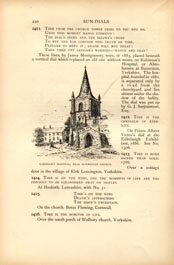
[Full Image]
ROBINSON'S HOSPITAL,
NEAR BURNESTON CHURCH.
| 1411. | TIME FROM THE CHURCH TOWER CRIES TO YOU AND ME. These lines, by James Montgomery, were, in 1883, placed beneath a vertical dial which replaced an old one without motto, on Robinson's Hospital, or Almshouses, at Burneston, Yorkshire. The hospital, founded in 1680, is separated only by a road from the churchyard, and lies almost under the shadow of the belfry. The dial was put up by G. J. Serjeantson, Esq. |
| 1412. | TIME IS THE CHRYSALIS OF ETERNITY. On Prince Albert Victor's dial at the Edinburgh Exhibition, 1886. See No. 1306. |
| 1413. | TIME IS MORE SACRED THAN GOLD. 1786. Over a cottage door in the village of Kirk Leavington, Yorkshire. |
| 1414. | TIME IS ON THE WING, AND THE MOMENTS OF LIFE ARE TOO PRECIOUS TO BE SQUANDERED AWAY ON TRIFLES. At Hesketh, Lancashire, with No. 31. |
| 1415. | TIME'S ON THE WING On the church, Botus Fleming, Cornwall. |
| 1416. | TIME IS THE MONITOR OF LIFE. Over the south porch of Welbury church, Yorkshire. |
